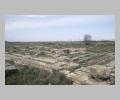| Context: | Metapontum |
| Type: | Temple |
| Summary: | Temple, probably dedicated to Hera, in the main religious sanctuary of the city; adjacent to the Temple of Apollo. |
| Date: | ca. 570 BC - ca. 530 BC |
| Dimensions: | Due to the poor state of preservation of the temple, the dimensions of the superstructure are difficult to obtain. The preserved foundations, however, indicate the following: overall dimensions of foundations of Temple BI 19.85 m. x 38.40 m. (resulting in a proportion of approximately 1:2). For Temple BI, the excavators propose 9 x 17 columns with an approximate interaxial spacing of 2.28 m. (facades) and 2.295 m. (flanks). Overall dimensions of foundations of Temple BII 19.85 m. x 41.60 m. |
| Region: | Lucania |
| Period: | Archaic |
Architectural Order:
Doric
Plan:
Two phases of Temple B have been identified. In the first phase (Temple BI), the temple was designed to be peristyle, with a groundplan of 9 x 17 columns, a central colonnade with an uncertain number of columns in the cella, and a pronaos. An additional row of foundations between the east facade and the pronaos suggests that another row of columns, perhaps five, was originally planned here. In this early phase the temple appears to have had an adyton.
In the second construction phase of the temple (Temple BII), the temple maintained its orientation and overall structure, but was extended by 3.30 m. towards the east, resulting in a wide east pteron. The number of columns was altered (to 7 x 15?), and, significantly, the peristyle was closed in through the erection of a wall which was articulated with half-columns. This half-columnar wall extended to the east to align with the front of the pronaos. The pronaos was deepened with the addition of an extra column on the flanks, for a total of five at the facade and two at the flanks. The pronaos was also tristyle in antis. Inside the cella, behind a row of four columns, was an adyton.
Date Description:
Ceramic sherds from the foundations of the first temple date to the first third of the sixth century B.C. The first construction phase was abandoned shortly after the middle of the sixth century, probably due to the new planning of the sanctuary and its two major temples. The excavators propose that reconstruction of Temple B began in ca. 530 B.C., but admit that the initiation of this second phase of construction is not securely documented by ceramic evidence.
History:
Ceramic evidence from the lowest foundation levels suggests that the earlier temple was begun sometime in the first half of the sixth century B.C. This temple was never completed. In ca. 530 B.C., work on the temple was renewed, and elements which had belonged to or were intended for the first temple were reused in the second temple (for example, monolithic columns which were used in the foundations of the second temple at the south, north and west). The excavators propose that construction of Temple BII was completed shortly after 530 B.C. Hundreds of fragments of architectural terracottas datable to the fifth century B.C. indicate that repairs to the roof were carried out at that time. The temple was destroyed in the late fourth century B.C.
Other Notes:
The orientation of both phases of Temple B is the same as that of the second phase of the neighboring
Other Bibliography:





